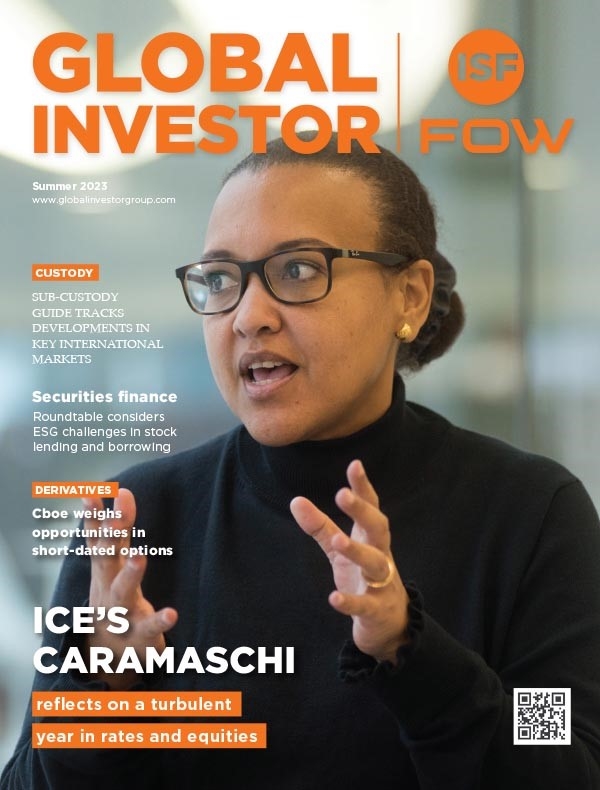Commerzbank: Collateral management: the tool of the trade
Robust use of collateral in both centrally-cleared and bi-lateral derivatives markets is the first defence against counterparty default and, therefore, systematic market failure. Consequently, collateral management regulation for the $700trn OTC derivatives market is as complex as it is forceful.
Across G20 countries, the combination of Basel III, the European Market Infrastructure Regulation (EMIR), Dodd- Frank in the US and a new global framework for non-centrally cleared derivatives by the Basel Committee on Banking Supervision (BCBS) and the International Organisation of Securities Commissions (IOSCO) are collectively transforming when collateral needs to be posted and how it is allocated, valued and reported, with daily margining set to be the norm.
OTC derivatives participants are being assailed on numerous fronts: regulation is demanding proper control, transparency and segregation of assets; at the same time commercial needs are forcing all participants in derivative markets to be ultra-efficient in how they use their assets as the cost of collateral rises.
Effective understanding and optimisation of collateral portfolios can reap substantial commercial benefits if done successfully. Additionally, with many firm transacting both CCP-cleared and bilateral transactions, they face the operation complexity of having to manage two market processes often across multiple jurisdictions and trading venues.
From a task that in some cases was typically conducted on nothing more technical than an excel spreadsheet, organisations are now having to consider how they can best secure the technology, processes and infrastructure in order to deliver collateral management that’s both fully compliant and commercially efficient.
Mobilising collateral supply
Of all the challenges facing the market, the key issue is whether there is actually enough quality collateral around to cover regulatory requirements. This is a particular concern given that both initial and variation margin will need to be posted for non-centrally cleared OTC derivative trades (except physically-settled FX), from December 2015, as part of the BCBS/ IOSCO global recommendations.
In 2013, the media was quick to pick up on the Bank for International Settlements’ conclusion that the combined impact of liquidity regulation and OTC derivatives reforms could generate additional collateral demand to the tune of $4trn.*
At the time, BIS concluded that high levels of AAA– and AA issuance suggested that concerns over an absolute shortage of high-quality assets (HQA) were unjustified. Even given recent sovereign debt crises in the Eurozone and restrictions on rehypothecation of customer collateral, we would argue that’s still the case.
There are generally sufficient quality assets that make a global collateral shortfall unlikely, plus there has been plenty of encouragement from regulators to enlarge the pool of eligible collateral from sovereign debt to also include corporate and covered bonds, equities and gold.
The greater challenge is that organisations often do not have the right collateral pools or assets in the right market at the right time. This needs to be addressed on a number of fronts:
1. Know what you’ve got: To date, many organisations have tended to work in silos, managing collateral within individual markets or product and business lines. This has often meant there is no overall understanding of what total assets an organisation has on its books at any one point and at a sufficient level of granularity. There have even been the cases where organisations struggle to understand the basic totality of their bank accounts operating worldwide – often the result of complex legacy systems and manual solution finding. Centralised inventory of all eligible assets coupled with a thorough understanding of the embedded commercial terms buried in legal agreements is now both essential and commercially sensitive.
It is advisable to conduct a review of all counterparty legal agreements (including CSAs and master agreements) and contracts which, in some cases, may not have been reviewed for years. As both counterparty and sovereign credit has fundamentally shifted following the global credit crisis, firms need to understand, and have sufficient process around, activities such as identification of cheapest to deliver assets in their contractual obligations. Getting this wrong – or worse not having clarity in relative optimisation of collateral obligations – can have a big impact on bottom-line performance.
2. Post by counterparty not by market: Counterparties need to be able to mobilise collateral across different markets and exchanges. By working with service providers who are able to look at an organisation’s activities globally – rather than by individual market/region – it is possible now to use effective book-entry transfers across an entire trading portfolio. So for example, when Asia closes, the available collateral can be used when European markets open, then moving on to support activities in the US market. The ICSDs – in particular Clearstream, with their Global Liquidity Hub product – are making significant progress towards freeing up and mobilisation of available and eligible collateral pools globally.
3. Optimise what you have: With the increasing importance of centralised oversight and management opens up the ability to optimise asset distribution across all of a firm’s collateral agreements, as well enabling opportunities for other optimisation strategies from collateral transformation, repurchase agreements, tri-party repo, GC Pooling and cross product netting, to name a few.
Firms are starting to look at collateral and liquidity pools more holistically. Innovation at exchanges are also evolving, such as Eurex Clearing Prisma, a portfoliobased margining approach which allows cross-margining between products as well as across markets, including across both listed and OTC positions. Solutions like this are already beginning to deliver 50-60% efficiency savings.
Mobilising collateral effectively across all jurisdictions and products will be absolutely key to ensuring capital efficiency and a stable supply of high-quality assets even in potentially stressed market situations.
Minimising manual activity
A great proportion of collateral management tasks are still conducted manually, from collateral booking to settlement to dispute resolution. According to the Sapient 2014 survey, collateral booking is still performed manually in over 60% of firms.
With daily margin calls alone expected to increase six-fold under the new regulations, firms will need to consider how these activities can be automated and fully integrated to avoid upward pressure on headcount and costs – whether through collateral management systems being introduced in-house or by outsourcing to a service provider – see below.
The need for two-way margining and increased daily margin calls is – alongside the increased demand for collateral – probably the biggest challenge that firms face. Greater adoption of straight-through processing will be essential for firms to cope.
The segregation challenge
Collateral segregation is now required in all G20 derivatives regulations. In the past, up to 60% of cash collateral has been segregated through omnibus accounts structures. But in line with EMIR requirements to offer a choice of segregation options – and following high-profile fines for poor client asset segregation – individual segregation at the finite level is gaining significant momentum.
Individual segregation of client assets and cash doesn’t come cheap. When the Securities industry has been largely built based around omnibus structures, the move to open this up will require some wholesale re-thinking and technology solutions from ICSDs and CSDs to the array of service providers.
The outsourcing opportunity
As all the challenges above show, the time and resource burden of efficient collateral management and reporting is substantial. Tier 1 financial institutions, CCPs and global custodians may be well-equipped to address this by allowing many aspects to be automated. But Tier 2 and 3 organisations and corporates are unlikely in many cases to be in a position to build sophisticated new systems, valuation and optimisation capabilities, or afford the infrastructure and people to support them.
For this reason, many of the commoditised activities of collateral management – settlement, reconciliation, valuations, interest calculation, dispute management and collateral matching – are increasingly likely to be outsourced, whilst retaining decision making in-house.
In its 2014 collateral management survey, Sapient Global Markets found that 43% of buyside firms are now using an external collateral manager.
What an organisation is willing to outsource will, of course, vary. Disputes are a case in point. While some market participants will be happy to offload issues arising over changes in collateral quality, payment delays, portfolio mismatches or valuation disagreements, other firms may feel the reputational issues are too important to delegate.
Nonetheless, firms must not underestimate the burden that requirements for daily collateral management, margining, reporting and valuations present. For all but the very largest financial institutions, some element of outsourcing is going to make commercial sense. What’s more, the cost of outsourcing is calculated on consumption of process.
So it can become a virtuous circle: the more efficient a client can be in its processes and documentation, the less it will cost to outsource its collateral management.
By outsourcing operational aspects, organisations can concentrate on the core decision-making that adds value to their business. With CCPs, custodians and investment banks and exchanges all jockeying for a slice of the outsourcing opportunity, firms need to be judicious in their choice of outsourcing partner.
What next?
In a new highly regulated and ultra-risk averse world, collateral management needs to be more dynamic than it ever was.
Firms are going to have to unravel inefficient and silo-based collateral management processes and systems. Counterparty agreements that have built up haphazardly market by market over the years will take time and resource to resolve and optimise. But the benefits of the robust and efficient collateral management that should result cannot be overstated.
Counterparties that can centralise, standardize, automate and outsource activities, that understand what assets they have on their balance sheet and can mobilise them to any market and crossproduct, will be the ones who achieve the greatest cost efficiencies – and even, greater levels of profitability. In the future, being in a position to respond quickly and decisively to changing market conditions will be paramount.
* BIS – CGFS Papers No 49 Asset encumbrance, financial reform and the demand for collateral assets, May 2013
| TradeCycle – a complete post-trade offering TradeCycle is an end-to-end post-trade solution provided by Commerzbank, Clearstream and Deutsche Börse Group. The only platform partnership of its kind between an investment bank and a global market infrastructure provider, it allows firms to outsource individual or multiple components of the post-trade process to dedicated experts. Working with the TradeCycle team, clients can build an outsourced solution to meet their specific needs for cost efficiency, risk management, improved return on assets or regulatory control. Alongside derivatives clearing, custody and trade reporting, TradeCycle spans the full spectrum of collateral management solutions. These include collateral optimisation, transformation and mark-to-market valuation plus third-party margin segregation and tri-party collateral management – helping clients ensure full regulatory compliance and assuring cost-effective liquidity for all their post-trading activities worldwide. For more on TradeCycle go to www.commerzbank.com/marketservices |
Found this useful?
Take a complimentary trial of the FOW Marketing Intelligence Platform – the comprehensive source of news and analysis across the buy- and sell- side.
Gain access to:
- A single source of in-depth news, insight and analysis across Asset Management, Securities Finance, Custody, Fund Services and Derivatives
- Our interactive database, optimized to enable you to summarise data and build graphs outlining market activity
- Exclusive whitepapers, supplements and industry analysis curated and published by Futures & Options World
- Breaking news, daily and weekly alerts on the markets most relevant to you



